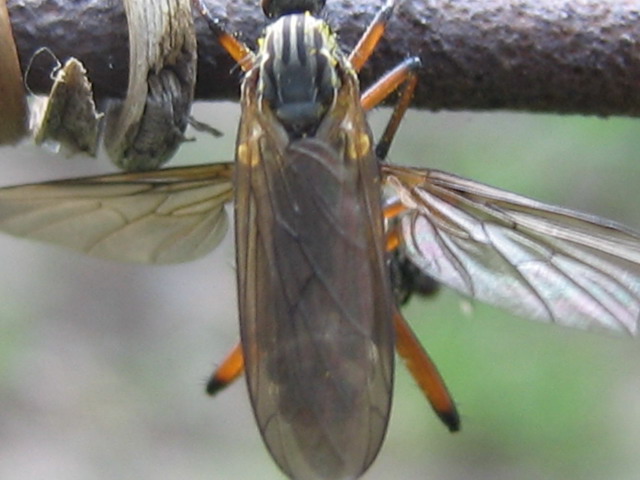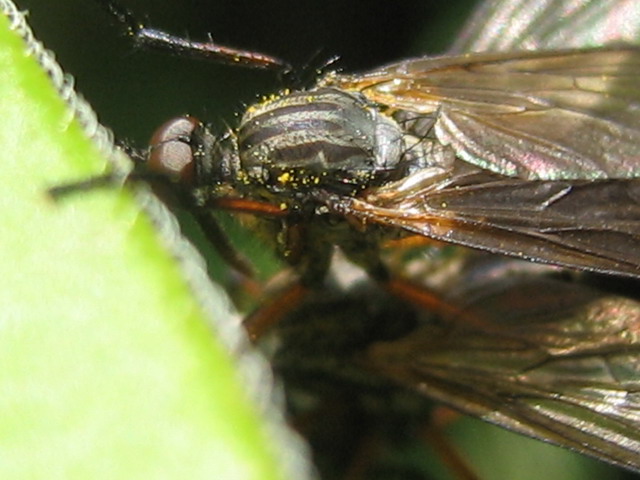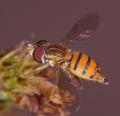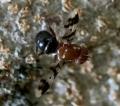Diptera.info :: Identification queries :: Diptera (adults)
Who is here? 1 guest(s)
|
Empis opaca
|
|
| eguzki |
Posted on 25-04-2007 11:12
|
|
Member Location: Perkáta, Hungary Posts: 1140 Joined: 12.10.06 |
Location: Hungary Habitat: garden Size: Roughly 1 cm Date: 25-04-07 These flies are pairing and the female eats her husband's gift!  Let me know more about them! Let me know more about them!
eguzki attached the following image:  [88.4Kb] Edited by eguzki on 26-04-2007 09:57 |
|
|
|
| eguzki |
Posted on 25-04-2007 11:14
|
|
Member Location: Perkáta, Hungary Posts: 1140 Joined: 12.10.06 |
second image:
eguzki attached the following image:  [75.23Kb] |
|
|
|
| eguzki |
Posted on 25-04-2007 11:14
|
|
Member Location: Perkáta, Hungary Posts: 1140 Joined: 12.10.06 |
third image:
eguzki attached the following image:  [83.37Kb] |
|
|
|
| Markus Gebel |
Posted on 25-04-2007 11:23
|
|
Member Location: Germany Posts: 210 Joined: 18.07.06 |
I think thats 'Empis opaca' (Empididae) That is a normal behavior. To the protection to be eaten, eats one fly their hives. Excuse my bad english  . .cheers markus Edited by Markus Gebel on 25-04-2007 11:31 |
| eguzki |
Posted on 26-04-2007 09:59
|
|
Member Location: Perkáta, Hungary Posts: 1140 Joined: 12.10.06 |
Hi Markus! Thank you for your help! I could understand well what you wanted to say to me!  |
|
|
|
| Adrian |
Posted on 26-04-2007 14:08
|
|
Member Location: Posts: 69 Joined: 05.01.07 |
Here are some notes from the litereature on is feeding & display which tell you the basics:- Preston-Mafham, K.G. (J. Zool. 247: 239-246 [1999]) notes that the males of E. opaca and E. tessella present a ?gift? in the form of a dead insect to the female before mating takes place. Females will not mate with males which do not present a gift and gifts presented during periods of sexual activity also appear to make a substantial contribution to female ovarian development. Some males seek to cheat by presenting substitute gifts such as fluff-bearing seeds of willows 1. Laurence (Bedfordshire Naturalist No 4 (1949),1950 4pp) saw males swinging back and forth ??as though on a horizontal pendulum??, either low down amongst herbage or higher up (10 feet near apple tree). They take Dilophus febrilis L [5 records] but will also attack sawflies (Priophorus varipes Lepepetier)[1 record]. He also notes it using seeds instead of insect prey. 2. Hobby & Smith (Bionomics of Empis tessellata EMM xcvii: 2-10[1961]) quote Hamm (1908,1909) and state that male opaca with prey fly over hedges, bushes & small trees in ?dancing?groups awaiting the arrival of females which they pursue. A successful male transfers prey to the female and couples while in the air. The pair then settles on veg. with the female eating pry while cop. continues. They say this differs from E. livida in which the females dance and it is the male which takes prey to the swarm. 3. Hobby & Smith (Bionomics of Empis opaca, EMM xcvii: 204-208 [1961 or 62]) describe egg & pupa.(latter from exuviae attached to legs of adult) Females from pairs which had completed copulation in the afternoon usually started egg-laying on the morning of the second day following. In vitro, females laid eggs in small groups of 1-5 (max 32). Eggs were white becoming yellowish by 12 hours. The female dies within 2-3 days of laying and eggs hatched after 8-13 days. They quote reports of epigamic behaviour by Hamm (1909), Gruhl (1924), Richards (1927) & Hobby (1937) and summarise as follows:- males with prey initiate courtship by flying rapidly above & about the meadow grasses on which the females rest. This display induces the females to rise in slow flight above the males. The male approached the female from below and coupling takes place in the air after which the pair fall a short distance before flying off to settle on the grass. During cop. the Male is uppermost and cop lasts from 20 sec to 5 mins.. After finishing cop. the male usually carries off the prey which is often dropped. Hobby (1932) is quoted as having seen a male use prey a second time to secure a second female. The prey is never retained by the female. Hobby also noted males catching wind-borne pappus-bearing fruits of Compositae and males were apparently as successful in securing copulation as those with insect prey. 1. Preston-Mafham, K.G. (J. Zool. 247: 239-246 [1999]) notes that the males of E. opaca and E. tessellate present a ?gift? in the form of a dead insect to the female before mating takes place. Females will not mate with males which do not present a gift and gifts presented during periods of sexual activity also appear to make a substantial contribution to female ovarian development. Some males seek to cheat by presenting substitute gifts such as fluff-bearing seeds of willows. In E. opaca such cheats enjoyed low rates of reproductive success compared with males presenting food gifts. Cheating appears to be an alternative mating tactic for males of this species. Hobby & Smith (Bionomics of Empis opaca, EMM xcvii: 204-208 [1961 or 62]) quote the following as prey:- PLECOPTERA (2 sp. 2 individuals); LEPIDOPTERA (2 spp. 2 indiv.); COLEOPTERA (1 sp , 1 indiv); HYMENOPTERA-TENTHREDINIDAE (8 spp. 7 indiv.); ICHNEUMONIDAE (1 sp, 1 indiv.); APIDAE (1 spp, 1 indiv); DIPTERA ? TIPULIDAE (1 sp. 5 indiv); CERATOPOGONIDAE (1 sp. 1 indiv.); BIBIONIDAE (8 spp. c 250 indiv.); EMPIDIDAE (8 sp, 30 indiv); SYRPHIDAE (2 sp, 4 indiv.); SCIOMYZIDAE (1 sp. 1 indiv.); SPAEROCERIDAE (3 sp, 3 indiv.); CHLOROPIDAE (1 sp, 1 indiv); PAPPI + FRUITS Taraxacum officinale, Senacio vulgaris. |
|
|
|
| Jump to Forum: |














